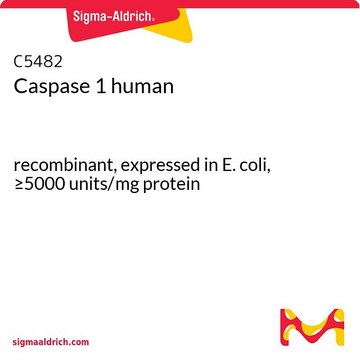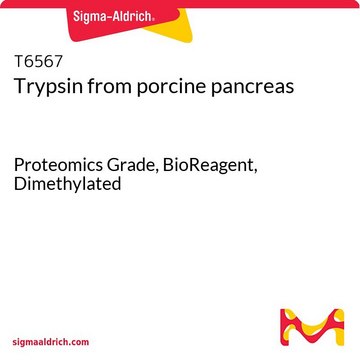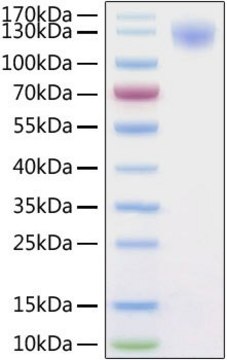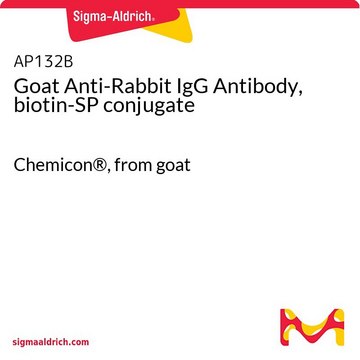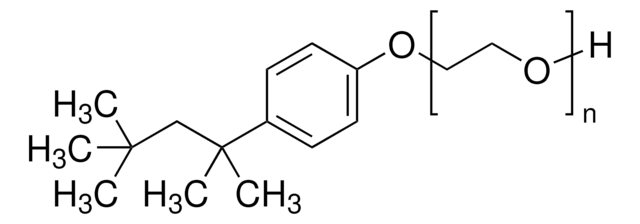CC126
Caspase 1, recombinant human active
Synonym(s):
Recombinant caspase 1
Sign Into View Organizational & Contract Pricing
All Photos(1)
About This Item
UNSPSC Code:
12352200
eCl@ss:
32160405
NACRES:
NA.41
Recommended Products
biological source
human
recombinant
expressed in E. coli
form
solid
manufacturer/tradename
Chemicon®
technique(s)
activity assay: suitable
NCBI accession no.
UniProt accession no.
shipped in
dry ice
General description
Caspase-1 (also known as ICE, Interleukin-1beta-Converting Enzyme) is the prototypical member of the caspase family of cysteine proteases. Caspase-1 exists in cells as an inactive 45 kDa pro-enzyme. The pro-enzyme is matured by proteolysis to yield large (20 kD) and small (10 kD) subunits. The active enzyme is a heterotetramer consisting of two large and two small subunits. To date the mechanism of regulation of caspase-1 activation is complex and poorly understood. In THP-1 cells, a large proportion of the caspase-1 is present in the inactive pro-enzyme form.
The active recombinant human caspase-1 was expressed in E. coli. The expressed caspase-1 spontaneously undergoes autoprocessing to yield the subunits characteristic of the native enzyme. The recombinant caspase-1 preferentially cleaves the substrates consisting of consensus sequence YVAD (e.g., YVAD-AFC and YVAD-pNA). The recombinant enzyme can also be used as a positive control in caspase assays or in determining the specificity of caspase substrates.
Recommended usage: 0.5-1 unit for fluorometric caspase assays and 2-4 units for colorimetric caspase assays. Optimal working dilutions must be determined by end user.
The active recombinant human caspase-1 was expressed in E. coli. The expressed caspase-1 spontaneously undergoes autoprocessing to yield the subunits characteristic of the native enzyme. The recombinant caspase-1 preferentially cleaves the substrates consisting of consensus sequence YVAD (e.g., YVAD-AFC and YVAD-pNA). The recombinant enzyme can also be used as a positive control in caspase assays or in determining the specificity of caspase substrates.
Recommended usage: 0.5-1 unit for fluorometric caspase assays and 2-4 units for colorimetric caspase assays. Optimal working dilutions must be determined by end user.
Physical form
Lyophilized. Reconstitute in 25 μL PBS containing 15% glycerol.
Storage and Stability
Maintain unopened and rehydrated product at -70°C in undiluted, freeze-thaw protected, tightly sealed aliquots. Avoid repeated freeze/thaw cycles. Product stable for 6 months from date of purchased if handled appropriately.
Analysis Note
Partially purified recombinant caspase 3 with a full length HIS-6-tag. Approximately 10-20% caspase 1 protein. The remainder is E.Coli proteins. Approximately 0.8-2 mg total protein/U of activity; E.Coli proteins have no reactivity.
Legal Information
CHEMICON is a registered trademark of Merck KGaA, Darmstadt, Germany
Disclaimer
Unless otherwise stated in our catalog or other company documentation accompanying the product(s), our products are intended for research use only and are not to be used for any other purpose, which includes but is not limited to, unauthorized commercial uses, in vitro diagnostic uses, ex vivo or in vivo therapeutic uses or any type of consumption or application to humans or animals.
Storage Class Code
11 - Combustible Solids
WGK
WGK 1
Flash Point(F)
Not applicable
Flash Point(C)
Not applicable
Certificates of Analysis (COA)
Search for Certificates of Analysis (COA) by entering the products Lot/Batch Number. Lot and Batch Numbers can be found on a product’s label following the words ‘Lot’ or ‘Batch’.
Already Own This Product?
Find documentation for the products that you have recently purchased in the Document Library.
Qianyue Chen et al.
European journal of immunology, 51(5), 1234-1245 (2021-01-18)
Pyroptosis is a type of acute cell death that mainly occurs in immune cells. It is characterized with robust release of inflammatory cytokines and has emerged to play a critical role in the pathogenesis of sepsis-associated immune disorders. In this
Timothy Connelley et al.
Veterinary research, 42, 37-37 (2011-02-25)
Natural killer (NK) cells are well recognized as playing a key role in innate immune defence through cytokine production and cytotoxic activity; additionally recent studies have identified several novel NK cell functions. The ability to study NK cells in the
Our team of scientists has experience in all areas of research including Life Science, Material Science, Chemical Synthesis, Chromatography, Analytical and many others.
Contact Technical Service
